A lacklustre series of results, an unforeseen transfer deal and sprightly press conferences – FC Barcelona have managed to be in the headlines ever since La Liga returned after the pandemic break. The defending champions dropped nine points since the restart, gifting rivals Real Madrid the title. Barcelona’s nightmares have come true – their off-the-field feuds have started influencing their gameplay and performance.
This scout report will inspect Barcelona’s attacking tactics, especially the shortcomings that have caused them to slip to second place. This tactical analysis will talk about all the aspects that seem to be wrong in their attack, and will try to decode why that happens. We’ll be looking at Barcelona’s attack after Quique Setién made his way to the Camp Nou back in January.
Where do Barcelona find themselves right now?
Former Real Betis manager Quique Setién made his way to the Camp Nou after Ernesto Valverde was sacked following a Super Cup semi-final defeat against Atlético Madrid. After coming in, Barcelona‘s attack has struggled to break through in the process, which will be further justified by the data we have available.
Barcelona have scored 74 goals in La Liga this season, overperforming their xG of 62.56. However, Setién ’s arrival has seen a dip in numbers, as Barcelona have scored 25 goals in the league against an xG of 28.85. This directly hints at the struggle and how Barcelona have underperformed this season. We will be looking at the tactics involved as the analysis progresses.
Similarly, Setién has tried out seven unique front-three combinations in the first 14 league games since his arrival. This can be a major point behind Barcelona’s attacking struggles – they’re yet to find their first-choice combination.
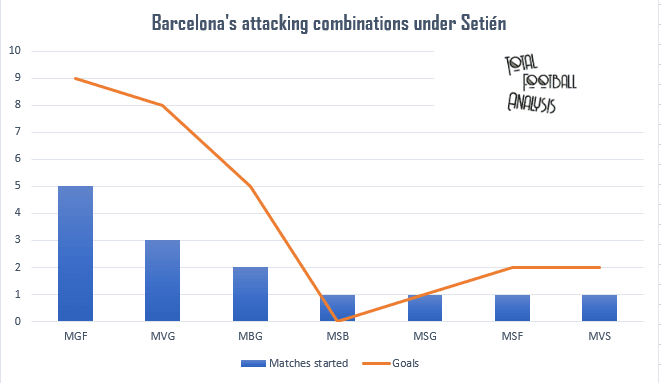
In the chart given above, the three letters denote the combination that started up-front, the letters are derived from player’s names. (For example: MGF means Messi, Griezmann, and Fati started the match).
The graph clearly suggests that Setién ’s most-used set of attackers include a combination of Lionel Messi, Antoine Griezmann and Ansu Fati upfront. The trio has scored nine goals in five appearances, and seem to be quite effective compared to other less-used and recently trusted attacking combinations.
Similarly, while comparing these combinations, we’re taking in Arturo Vidal as an attacker and a part of the front-three, as the Chilean is used more towards the front three than a box-to-box by Setién .
Going into the chart again, we can see Luis Suárez appearing as a constant figure after his return from the injury. Griezmann, still struggling to adapt to Barcelona’s system, has featured in four different combinations of attackers, hence making it harder for him to get things in place. Talking about the statistics, the Frenchman has managed to score just one league goal under Setién , underperforming his xG of 3.20.
This has been a problem for almost every Barcelona attacker, as Messi too has just nine league goals from an xG of 11.68. In a broader picture, Messi’s overall league tally stands at 22 goals – overperforming his xG by 18.38. The crisis is apparent statistically here, as attackers have not been able to convert and overall, Barcelona have not been able to impress.
The analysis will now look at the loopholes in Barcelona’s attacking tactics.
The real-time positional switch and its drawbacks
As has already been mentioned above, Arturo Vidal is more of an attacker in Quique Setién ’s Barcelona than a traditional box-to-box midfielder. Vidal is seen occupying the right side of the attacking line frequently, even swapping places with Lionel Messi regularly. There are two types of movements that this swap creates:
- When two forwards (including a left-winger) start alongside Messi, Messi is seen dropping deep towards the right flank inorder to fetch the ball and get it into the box.
- When only one forward (a striker) starts with Messi, Vidal occupies Messi’s position and Messi gets a more liberal role, even going towards the left to establish a link-up.
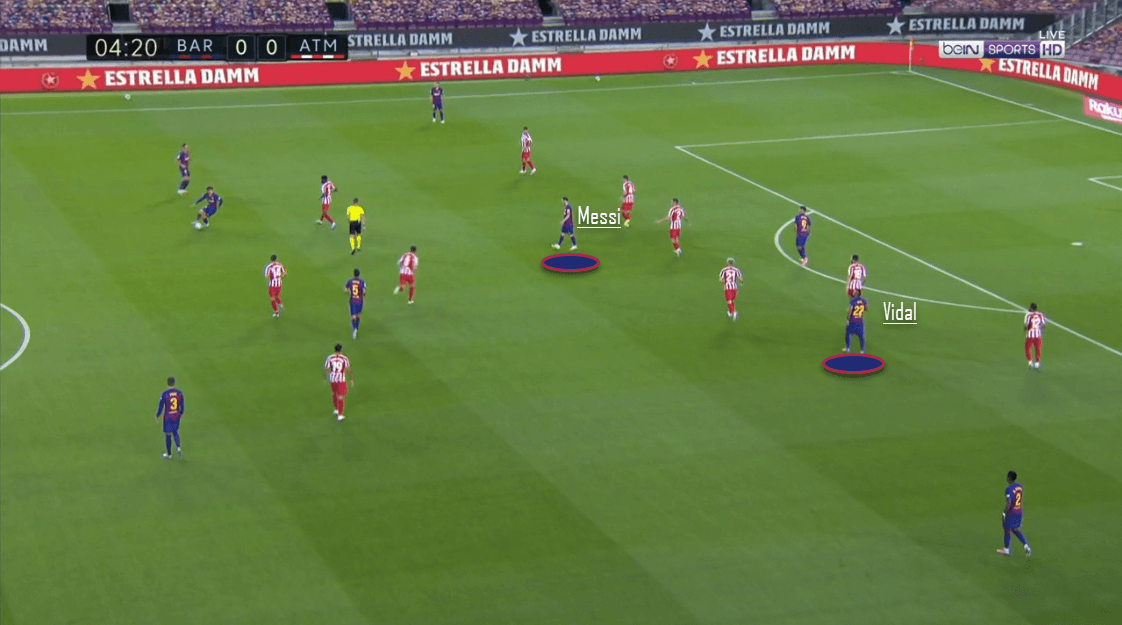
In the action shown above, only Suárez starts as a forward alongside Messi. Thus, we can see Messi dropping slightly below Suárez to contribute to the play and supply balls for the forwards.
A similar swap is visible when both Griezmann and Martin Braithwaite start together. When this happens, Griezmann has the freedom to drop deep towards the left to provide support to the midfield. Both Messi and Griezmann seem to do this simultaneously when both Braithwaite and Vidal start, as Griezmann drops towards the left and Messi drops towards the right.
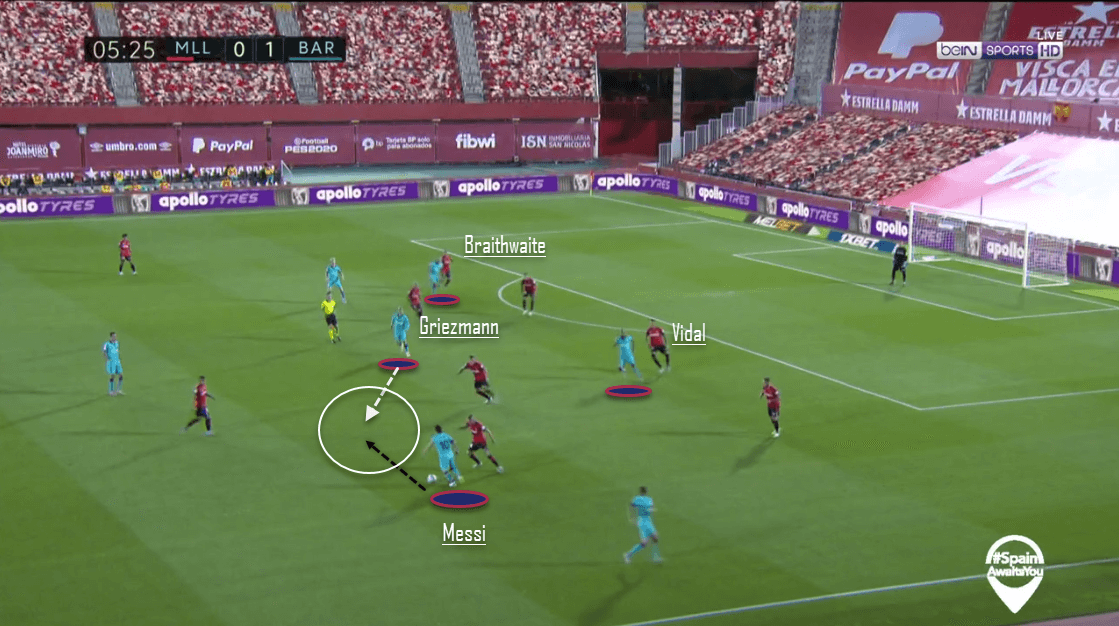
We can see in the instance above, Griezmann drops to support Messi in the play, whereas Braithwaite and Vidal are both placed in an advanced position, ready to poach in front of goal.
One might ask, how is this a drawback? First things first, this decreases both Griezmann’s and Messi’s influence in the box. Decreasing these world class players’ influence in the box results into a dull finishing. Barcelona cannot properly take advantage of both the players’ individual skill and goal-scoring capabilities. Both Braithwaite and Vidal lack the clinical finishing skills that this duo carries, and hence, despite creating chances and yielding high xGs, Barcelona are not able to finish on several occasions. Similarly, sides that have recently featured against Barcelona have been able to block the lines between the play-making forwards and Vidal-Braithwaite duo, causing Barcelona to lose balls frequently whenever they try to put on a through ball.
Has the approach been too predictable?
The immediate answer is yes. Barcelona’s approach of trying to overhaul the central area (zone 14 to be precise) has been too predictable. After the restart, almost every side that Barcelona have faced have been able to contain Barcelona in their central attack.
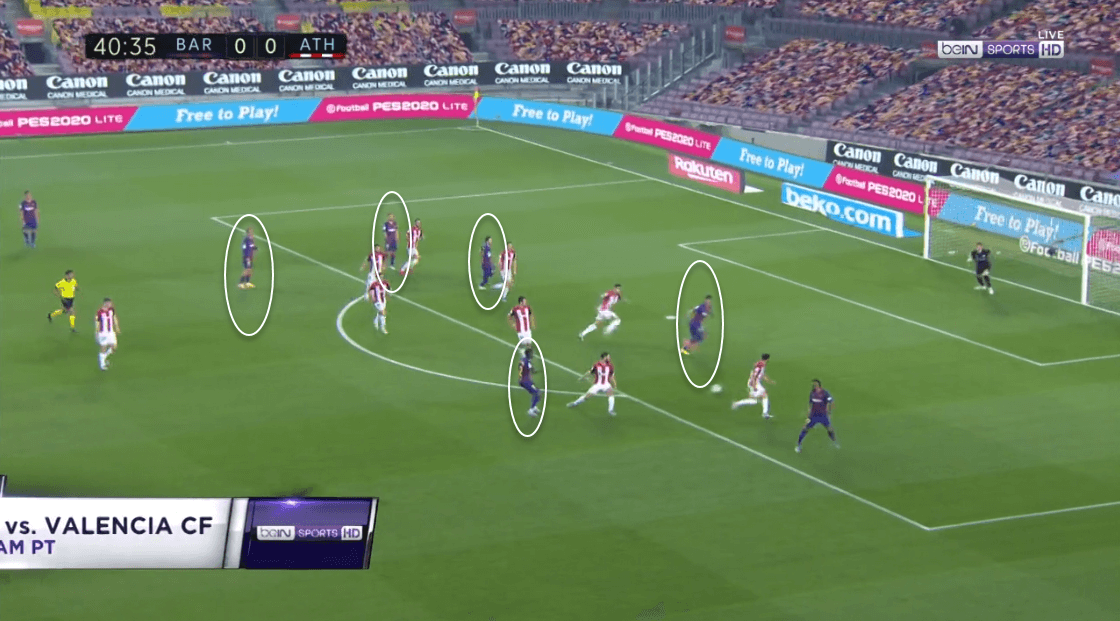
Barcelona try to build-up using the pitch as a whole – using the wide side as well as the central area. However, when it gets to one of their attackers, they prefer to approach via the central route and create an overhaul near the ball, effectively trying to keep the ball within the reach and attacking in numbers. The wide areas are not used to land the ball or penetrate under the new management, it is rather used to supplement and distribute the ball towards zone 14. Hence, as we can see in the picture above, five Barcelona players are concentrated around that central zone only.
This approach of creating central overhaul is influenced by the players that are available. Both Suárez and Braithwaite love to start as a centre-forward and are preferably centre-oriented throughout the match. Similarly, Messi and Griezmann, the run makers, the ball-receivers also have a tendency to start from their respective positions and drift towards the centre to make a pass or have a shot on goal. Hence, all of these contribute to Barcelona’s preference to the central space. The case becomes slightly different when Ansu Fati starts, which we’ll discuss later.
This attribute has been a regular and predictable approach and as a result, sides have started creating a narrow and compact central-block, making Barcelona difficult to penetrate. In the process, these layered blocks are also capable of blocking the passing lanes, further increasing the supply problem.
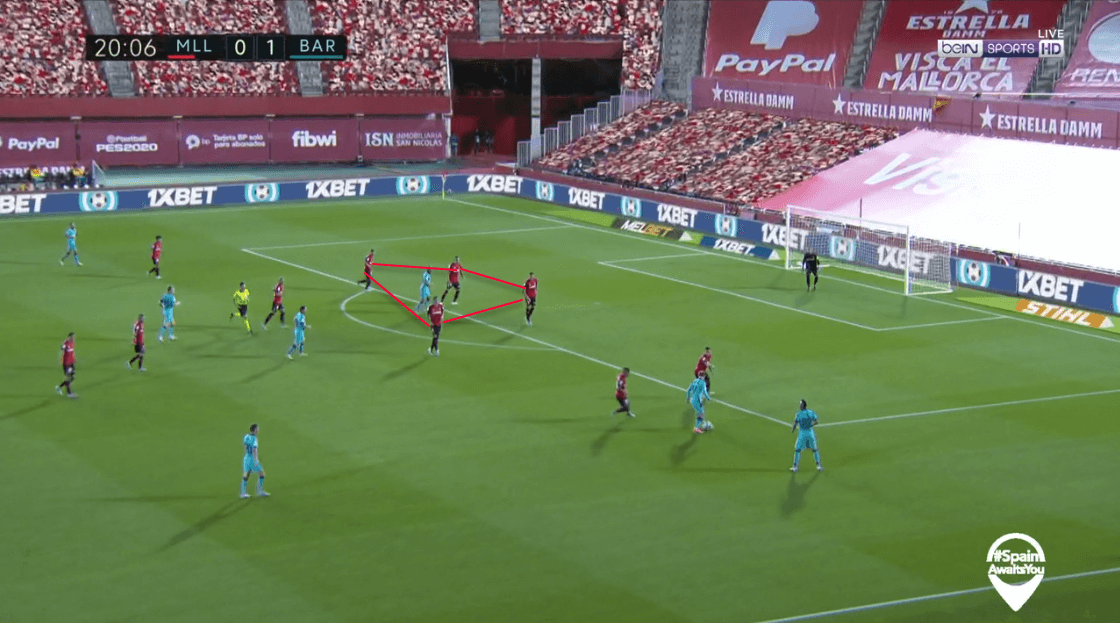
The above instant summarises what teams frequently succeed in doing against Barcelona – they’re able to block the passing lines that end up in the target man. As a result, Barcelona have been very much reliant on Lionel Messi’s individual brilliance to break the dreadlock.
Similarly, defensive teams like Athletic Club and Atlético Madrid, capable of defending deep, also create a cage-like defensive structure against Barcelona, effectively blocking their attempts to penetrate. This approach delays the time of attack, and as a result, Barcelona are slow in transition, combined with their past their best forwards.
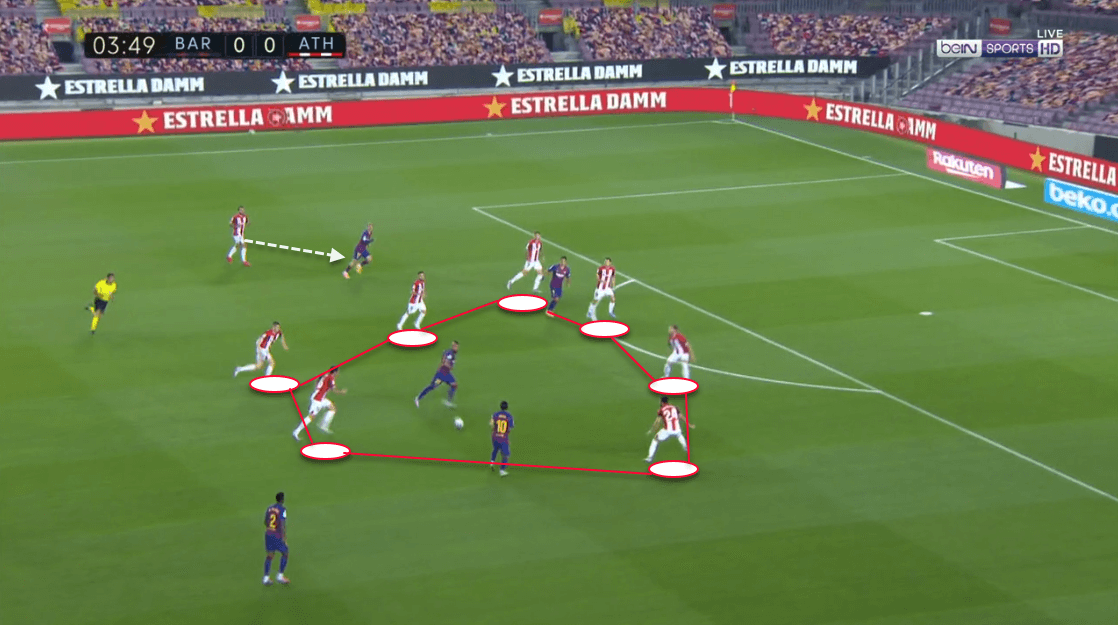
In this instant, we can see seven Athletic players surrounding the four attacking players. Also, the defence lies around the run-maker, making it harder for the attacker to advance forward as well.
Using this approach and not having an effective alternative has made Barcelona too predictable and their attack just falls into the hands of the central block.
Empty half-spaces and full-backs’ movements
Like I pointed out above, central overhaul is a strategy that Barcelona have adopted and have failed to utilise effectively after the restart. However, the central overhaul creates problems in the wider side of the pitch. In this case, Barcelona have not been able to use the half-spaces to transition and penetrate in the opposition box.
The central overhaul leaves half-spaces empty, which often results in Barcelona losing the ball as they try to shoot or pass sideways to the other players in the final third. The congested overhaul, therefore is easy for the opponents to intercept. Using the half-space’s width to switch plays sideways and release the full-backs to stretch the opposition defence can be an effective solution to this.
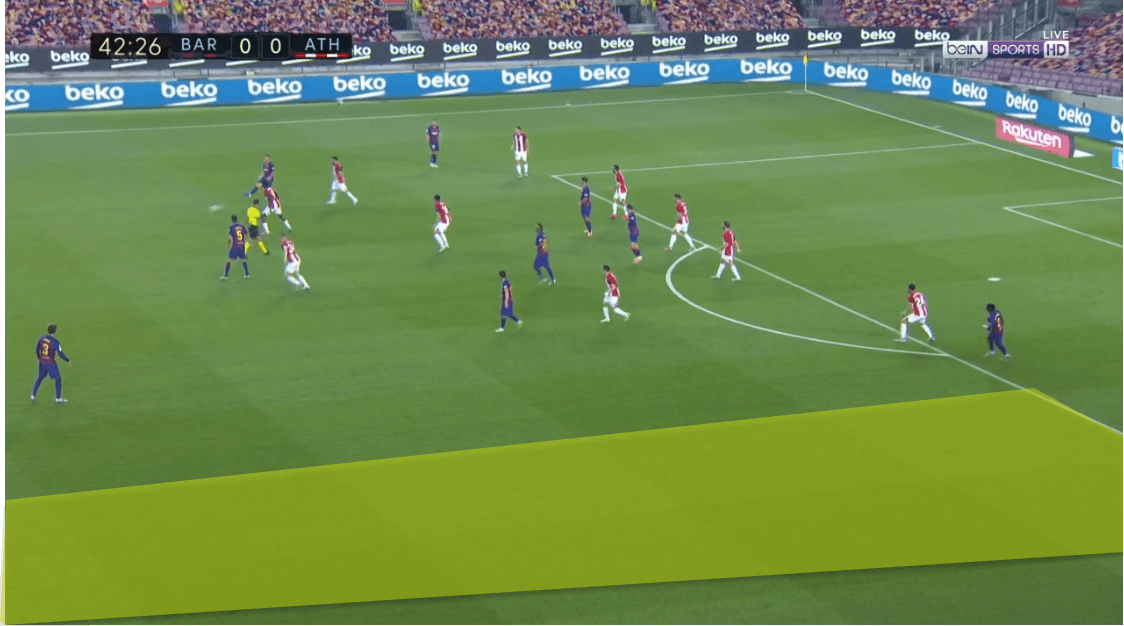
We can see in the picture, the half-space is left empty, as Nelson Semedo comes-in to support the overhaul. As a result, the opponent now can defend only one side of the pitch, as there’s no-one present on the void to capitalise and land the ball in a difficult position. Similarly, the full-backs cannot perform inside-out movement when they’re made to compensate and get involved in the overhaul.
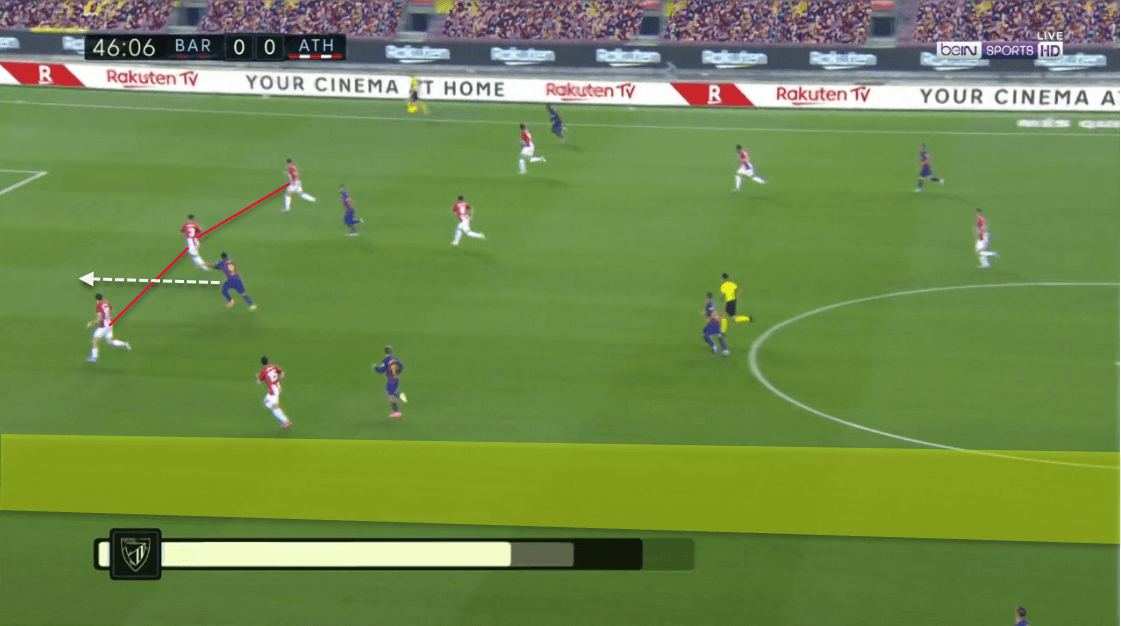
In this instant as well, the acting left-forward, Griezmann, tends to drift in as well, leaving the half-space empty. The ball carrier, Nelson Semedo has no safe passing option, as the forward is being shielded by a three-man defensive line and is not in a favorable condition to keep the ball and shoot. Similarly, pausing and passing behind will only slow down the attack, giving time for the opposition defence to arrive and lay a compact block again. Hence, the only option left is to execute a long pass to the other side. However, considering that long passes have high chances of error, a mis-hit would result in the end of the attack, as Jordi Alba is too far at the other end to collect the ball swiftly and maintain the attack. Hence, this is one of the reasons why Barcelona have not been able to use width and switch to cause problems.
Lack of Messi-Griezmann partnership
Griezmann arrived at Barcelona from Atlético Madrid this summer, with ambitions of achieving more than what he had won under Diego Simeone. However, Griezmann has not been able to find his rhythm to date and things have only been worse after the former Betis boss arrived at the Camp Nou.
Messi and Griezmann, two of the finest talents of their generations, have not yet been able to come-out with an effective pairing, as both of these men struggle to perform in each others’ presence. With both players preferring the central space to attack, this is more than just a classic case of redundancy in attack.
Despite Luis Suárez’s dip in performance levels in recent times, the only reason he has started so many games is because of his ability to pull off instinctive goals and most importantly, his link-up abilities with Messi. However, in Griezmann’s case, the Frenchman has not been able to properly adapt with Messi.
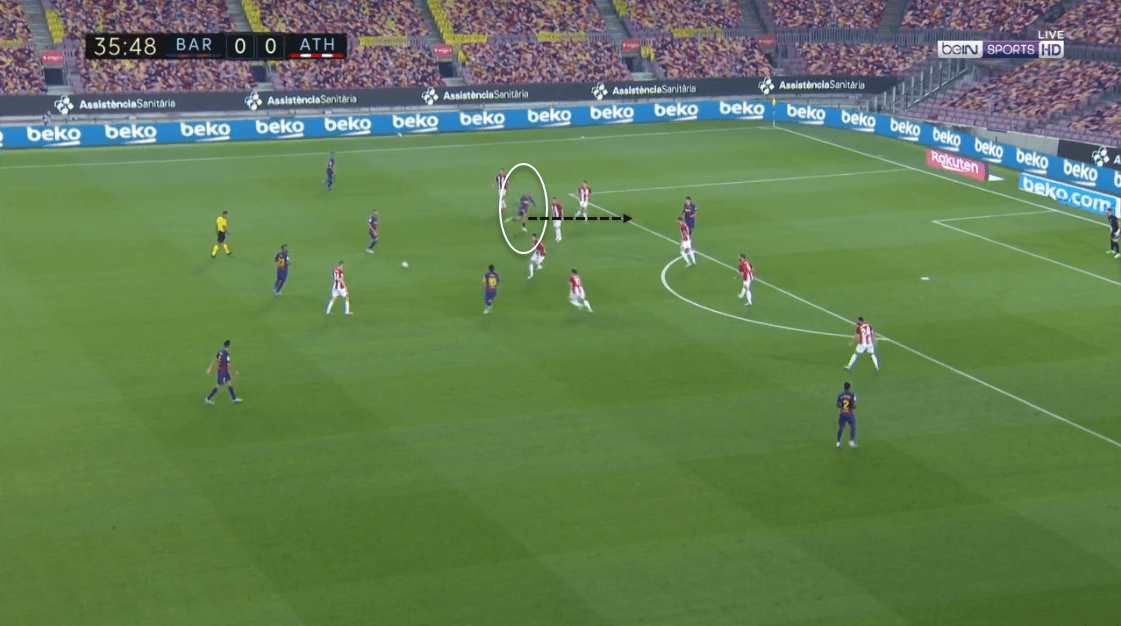
In the instance above, Messi is not able to spot Griezmann’s run, which is directed towards the box. Instead, he opts to receive the ball and do a one-two, ultimately losing the ball to two opposition players closing in on him.
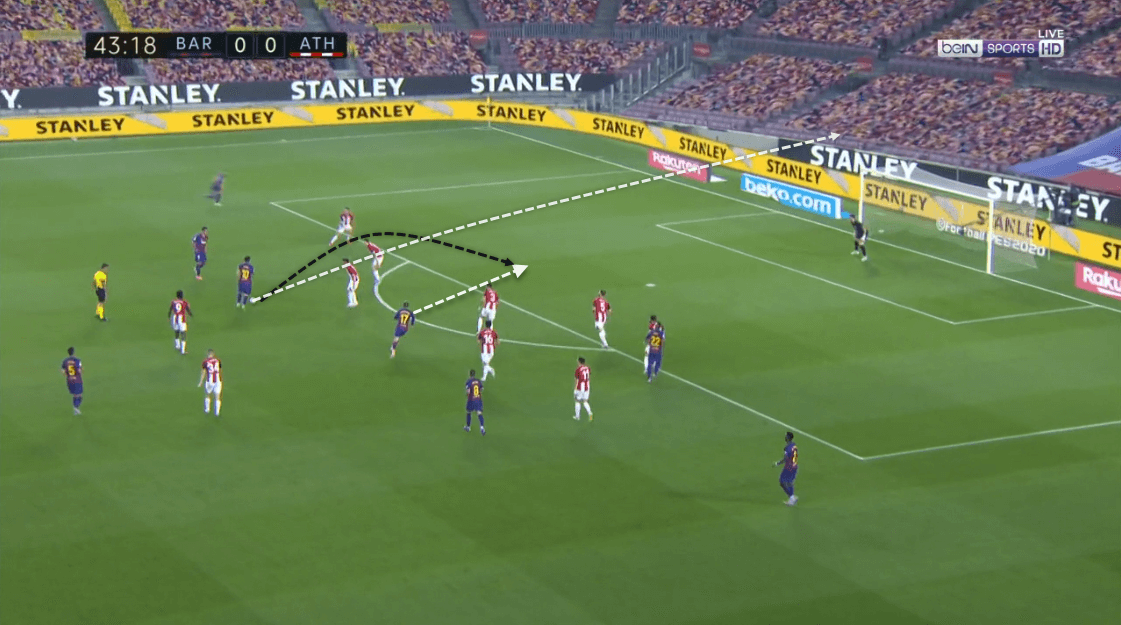
Similarly, in this instance, Messi opts to shoot rather than passing it to the run-making Griezmann, who can execute a shot that will yield a better xG value in the process. To put things into perspective with an example, only one passing combination was made between Griezmann and Messi when they both started against CD Leganés. Messi’s preference to pass to Suárez, as a result of Barcelona’s preference to penetrate via the central lane has made the link-up between Messi and Griezmann combination phase-out. Similarly, Griezmann is not able to read Messi’s movements including the other forwards’ moves, which has only complicated Barcelona’s attacking problems despite Messi-Griezmann-Fati being the most used and highest scoring trio under the new manager.
Conclusion
Barcelona have put themselves in a position where they require a major change in the squad. Not that they lack talents, but the Blaugrana lack the players that can fit into their tactics. With the midfield struggling to control the middle of the pitch and supply the forward line, Setién needs to find a proper combination of attackers to start for his side regularly. With Riqui Puig showing the promise of becoming a controller that can facilitate Messi and Ansu Fati showing signs of becoming a player able to provide width and exploit opposition’s jelly legs, Barcelona will look to sort things out in attack soon, to do their job well and wait for rivals to help them regain domestic glory.






Comments